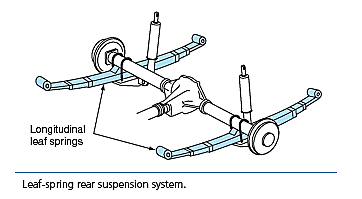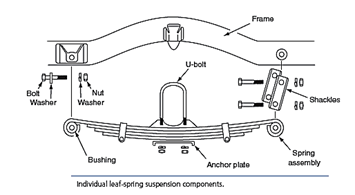Live-axle Rear Suspension Systems
Introduction:
Unsprung weight refers to the weight that is not supported by the springs, which includes the weight of the suspension system. The leaf-spring rear suspension was one of the first widely used rear suspension systems. Because this type of rear suspension system has weight and ride-quality disadvantages, it has been replaced on many vehicles with independent or semi-independent rear suspension systems.
Leaf-Spring Rear Suspension

- A leaf spring is mounted longitudinally on each side of the rear suspension on some rear-wheel drive cars and trucks.
- These relatively flat springs provide excellent lateral stability and reduce side sway, which contribute to a well-controlled ride with very good handling characteristics.
- However, leaf-spring rear suspension systems have a lot of unsprung weight, and leaf springs require a considerable amount of space.
Semielliptical springs
- The semielliptical springs have steel leaves and zinc or plastic interleaves to reduce corrosion, friction, and noise. A large rubber bushing is installed in the front eye of the main spring leaf, and a bolt retains this bushing to the front spring hanger.
- The rear spring shackle is bolted to a rubber bushing in the rear main leaf eye, and the upper shackle bolt extends through a similar rubber bushing in the rear spring hanger.
- Some rear spring shackles contain threaded steel bushings or a slipper mount in which the end of the spring slides through the shackle. Shackle insulating bushings help prevent the transfer of noise and road shock from the suspension to the chassis and vehicle interior.
- When a rear wheel strikes a road irregularity, the spring is compressed and the spring length changes. The rear shackle provides fore-and-aft movement with variations in spring length.

Because the differential axle housing is a one-piece unit, jounce and rebound travel of one rear wheel affects the position of the other rear wheel. This action increases tire wear and decreases ride quality and traction.

The differential axle housing is mounted above the springs, and a spring plate with an insulating clamp and U-bolts retains the springs to the rear axle housing. The shock absorbers are mounted between the spring plates and the frame.